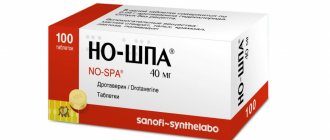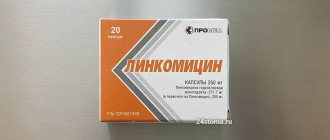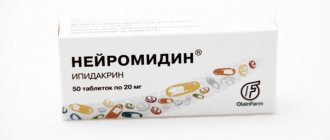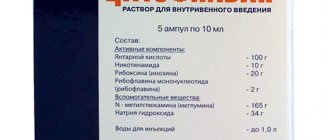Pharmacodynamics and pharmacokinetics
Mannitol - what is it?
Mannitol is an osmotic diuretic.
Pharmacodynamics
By increasing the osmotic pressure of plasma and enhancing filtration without tubular reabsorption , it promotes fluid retention in the tubules and an increase in the amount of urine. osmolarity increases, causing fluid to leak out of the tissues into the vascular bed. This leads to a pronounced diuretic effect, in which a large volume of osmotically free fluid, chlorine and sodium is excreted, without significant loss of potassium . Causes an increase in the amount of circulating blood.
Pharmacokinetics
In the liver, Mannitol undergoes minor metabolism to form glycogen . During excretion tubular reabsorption ; the process is controlled by glomerular filtration . The half-life is approximately 100 minutes. Excreted by the kidneys.
Buy Mannitol solution for infusion 15% 200ml in pharmacies
Instructions for use Mannitol solution for inf. 15% 200ml Dosage forms solution for injection 150mg/ml 200ml Synonyms Mannitol Group Osmotic diuretics International nonproprietary name Mannitol Composition Active ingredient - mannitol. Manufacturers Biokhimik OJSC (Russia), Kraspharma (Russia), Eskom NPK (Russia) Pharmacological action Decongestant, diuretic. Increases osmotic pressure in the tubules and prevents water reabsorption. Filtered by the kidneys without subsequent tubular reabsorption, which results in water retention in the tubules and an increase in urine volume. At the same time, natriuresis increases significantly without a significant increase in kaliuresis. The greater the dose, the higher the potency. Not effective in cases of impaired filtration function of the kidneys, as well as in azotemia in patients with liver cirrhosis and ascites. Causes an increase in blood volume (due to an increase in osmotic pressure in the vascular bed). Side effects Dehydration, dyspepsia, hallucinations, electrolyte imbalance. Indications for use Cerebral edema, increased intracranial pressure in renal or renal-hepatic failure, status epilepticus, acute attack of glaucoma, operations with extracorporeal circulation, acute renal (with preserved filtration function of the kidneys) and liver failure, post-transfusion complications caused by the introduction of incompatible blood, acute poisoning with barbiturates and other substances (forced diuresis). Contraindications Hypersensitivity, severe renal failure, impaired renal filtration function, congestive heart failure, hemorrhagic stroke, subarachnoid hemorrhage (except bleeding during craniotomy), hyponatremia, hypochloremia, hypokalemia. Overdose No data available. Interaction No data available. Special instructions Should be used with caution in the presence of left ventricular failure due to the risk of developing pulmonary edema; To avoid this in these cases, it is necessary to combine mannitol with fast-acting loop saluretics. Therapy must be carried out under the control of water-electrolyte balance and central hemodynamics. A 10% solution can be prepared at room temperature, 15% and 20% solutions can be prepared by heating in a water bath to 37 °C. In a 20% solution of mannitol, especially when it is cooled, crystals may form, to dissolve which it is necessary to heat the bottle in hot water or in an autoclave, shaking occasionally. Cool to body temperature or below before use. Storage conditions List B. In a dry place at a temperature of 18 - 20 ° C.
Indications for use Mannitol
The drug has the following indications for use:
- oliguria in acute renal failure glomerular filtration );
- cerebral edema ; status epilepticus ; intracranial or intraocular hypertension , exacerbation of glaucoma ;
- acute liver failure;
- post-transfusion complications after transfusion of incompatible blood;
- poisoning with salicylates, barbiturates, lithium preparations, bromides; forced diuresis in case of poisoning with other substances;
- to prevent hemoglobinemia and hemolysis during resection of the prostate using the transurethral method, during bypass surgery on the pulmonary-cardiac system, during procedures involving extracorporeal circulation .
Mannitol (mannitol)
Mannitol
or
mannitol
(Latin
mannitum
, English
mannitol
) is an alcohol from the group of sugars. Mannitol is widely used in the pharmaceutical and food industries. In modern medicine, mannitol is considered mainly as an intravenously administered osmotic diuretic, a means of promoting the removal of fluid from the body. In the recent past, mannitol has been listed as an osmotic laxative. Currently, among the drugs registered in Russia, there is not a single dosage form of mannitol (mannitol) positioned as a laxative. In pharmaceuticals, mannitol is often used as an excipient, inactive substance.
Mannitol is a chemical compound
Mannitol (mannitol or d-mannitol) is a hexahydric hydrocarbon alcohol from the group of sugars. Mannitol is a stereoisomer of sorbitol. The empirical formula for mannitol is C6H8(OH)6. Molar mass 182.172 mol-1. The melting point of mannitol is about 167 °C (7.6 mmHg), boiling point is 295 °C (at 3.5 mmHg).
Mannitol is a medicine
Mannitol is the international nonproprietary name of the drug. According to the pharmacological index, mannitol belongs to the group “Diuretics”. According to ATC, mannitol is included in the following groups:
- "B05. Plasma replacement and perfusion solutions", subgroup "B05BC Osmodiuretics" and has code B05BC01
- "A06. Laxatives", subgroup "A06AD Osmotic laxatives" and has code A06AD16.
- From 2021, mannitol is also included in group “V04. Diagnostic drugs" and is assigned the code V04CX04.
Mannitol and mannitol, in addition, are trade names of drugs produced by different manufacturers in the form of a solution for infusion or a powder substance for the preparation of such a solution.
Indications for use of mannitol
- acute renal failure (in the oliguria phase)
- acute liver failure
- cerebral edema
- intracranial hypertension
- intraocular hypertension
- acute attack of glaucoma
- operations with extracorporeal circulation
- post-transfusion complications after administration of incompatible blood
- poisoning: barbiturates, salicylates, bromides, lithium and other substances that require accelerated removal of fluid from the body
- prevention of hemolysis and hemoglobinemia during transurethral resection of the prostate gland and other surgical procedures.
Method of administration and dosage of mannitol
Mannitol is administered intravenously slowly in a stream or drip, in the form of a 10–20% solution at a dose of 0.5–1.5 g per kg of patient weight. The daily dose of mannitol should not exceed 140–180 g. The lyophilized mass of mannitol is dissolved without prior preparation with water for injection or a 5% dextrose solution. During operations with artificial circulation, 20–40 g are injected into the device immediately before the start of perfusion.
Mannitol is a gastrointestinal remedy.
In large doses, more than 20 g orally, mannitol acts as an osmotic laxative.
The therapeutic effect of osmotic laxatives is to attract water into the intestinal lumen along an osmotic gradient. This is accompanied by an increase in the volume of contents and easier movement, the consistency of stool becomes softer, and the frequency of bowel movements increases. The undesirable side of the action of osmotic laxatives is that their action spreads throughout the intestines and carries the risk of electrolyte disturbances, whereas the point of application of the “ideal laxative” should be the colon. In patients with cardiovascular and renal failure, salt osmotic laxatives can provoke volume and electrolyte overload (Shulpekova Yu.O.). Osmotic agents are used to treat constipation of unknown cause (American Gastroenterological Association. Constipation. The essence of the problem). Long-term use of mannitol can cause diarrhea (Belousova E.A., Zlatkina A.R.). The FDA category of risk for the fetus when taking mannitol in a pregnant woman is C (animal studies have shown adverse effects of the drug on the fetus, and there have been no adequate studies in pregnant women, but the potential benefits associated with the use of this drug in pregnant women may justify its use, despite at the existing risk).
Currently, mannitol is not used as a laxative.
Mannitol has contraindications, side effects and application features; consultation with a specialist is necessary.
Use of mannitol in industry
Mannitol (mannitol) is a food additive E421, approved for use in Russia, Ukraine and other countries.
In the food industry, mannitol is used as a sweetener and anti-caking agent. Used in the manufacture of chewing gum. Mannitol is used in the production of resins, drying oils, varnishes and other surfactants, in the manufacture of explosives, and in perfumes.
As an excipient, mannitol is present in many medications: Maalox, Panum, Taltsid, Gastrozol, Omeprazole-acri, Gastal, Gastracid, Gaviscon, Motilium, Pariet, Omez, Imodium, Rabelok, Zulbex, Lancidom, Razo, Gastromax and others. Back to section
Instructions for use of Mannitol (Method and dosage)
Instructions for use of Mannitol indicate that this drug is administered intravenously (slow drip or jet method). The preventive dosage is 500 mg per kilogram of weight, the therapeutic dosage is 1.5 g per kilogram of weight. The highest daily dose is 140-180 g.
For interventions with extracorporeal circulation, 20-40 g of the drug is administered immediately before the intervention.
Patients with oliguria are first administered intravenously 200 mg per kg of body weight over 5 minutes. If within 3 hours after this there is no increase in diuresis to 30-45 ml/g, then administration of Mannitol should be abstained in the future.
Mannitol
100 ml in glass bottles with a capacity of 100, 200 ml in glass bottles with a capacity of 250 ml, 400 ml in glass bottles with a capacity of 450 ml, sealed with rubber stoppers and crimped with aluminum caps.
Labels made of label or writing paper or other paper of a quality not lower than specified are glued onto the bottles.
For sale through the pharmacy chain, each bottle, along with instructions for medical use, is placed in a cardboard pack for consumer packaging of brands A and B.
36 packs of 100 ml bottles or 28 packs of 200 ml bottles or 15 packs of 400 ml bottles are placed in a consumer packaging box or corrugated cardboard box.
For hospitals: 36 bottles of 100 ml or 28 bottles of 200 ml or 15 bottles of 400 ml together with instructions for medical use in a quantity corresponding to the number of primary packagings, placed in a cardboard box for consumer packaging with a cardboard lining or in a cardboard box corrugated with gaskets and grilles (sockets).
100, 200, 250, 300, 400, 500, 600, 800, 1000, 2000, 3000 ml in polymer containers formed in the production process from polyolefin film for the manufacture of soft containers for infusion solutions, three-layer coextrusion or polyethylene copolymer film propylene for the manufacture of soft containers for infusion solutions, multilayer polymer or one-piece or separate tubular film APP114 made of polyolefin and polypropylene, and sealed with polycarbonate ports with a stopper made of gray rubber and a cap made of aluminum and propylene to soft containers for infusion solutions or ports made of polypropylene ( systems for sealing polypropylene containers) or into single-use Siflex Pack polypropylene polymer containers with a stopper and adapter for infusion solutions, hemopreservatives, blood substitutes, biological products and water for injection, or into soft polypropylene polymer containers for infusion solutions.
Text is applied to the surface of the container or a label is glued from label or writing paper or from other paper of a quality not lower than specified.
For sale through the pharmacy chain, each polymer container, along with instructions for medical use and guidelines for the use of polymer containers with infusion solution, is packaged in a bag made of polyethylene film or biaxially oriented polypropylene film.
Text is applied to the surface of the film bag using thermal printing.
44 100 ml resin containers, 32 200 ml resin containers, 24 or 28 250 ml resin containers, 20 300 ml resin containers, 16 400 ml resin containers, 12 500 ml resin containers, 10 600 ml resin containers , 8 polymer containers with a volume of 800 ml, 6 polymer containers with a volume of 1000 ml, 4 polymer containers with a volume of 2000 ml, 2 polymer containers with a volume of 3000 ml in bags or without bags (for hospitals) together with instructions for medical use and instructions for the use of polymer containers with infusion solution in an amount corresponding to the number of polymer containers is placed in a cardboard box for consumer packaging or in a corrugated cardboard box.
special instructions
In the event of the development of symptoms such as vomiting, headache, visual disturbances, dizziness , the drug should be stopped and the development of subdural or subarachnoid hemorrhage .
When using the drug, you should monitor blood pressure, diuresis electrolyte levels in the blood.



